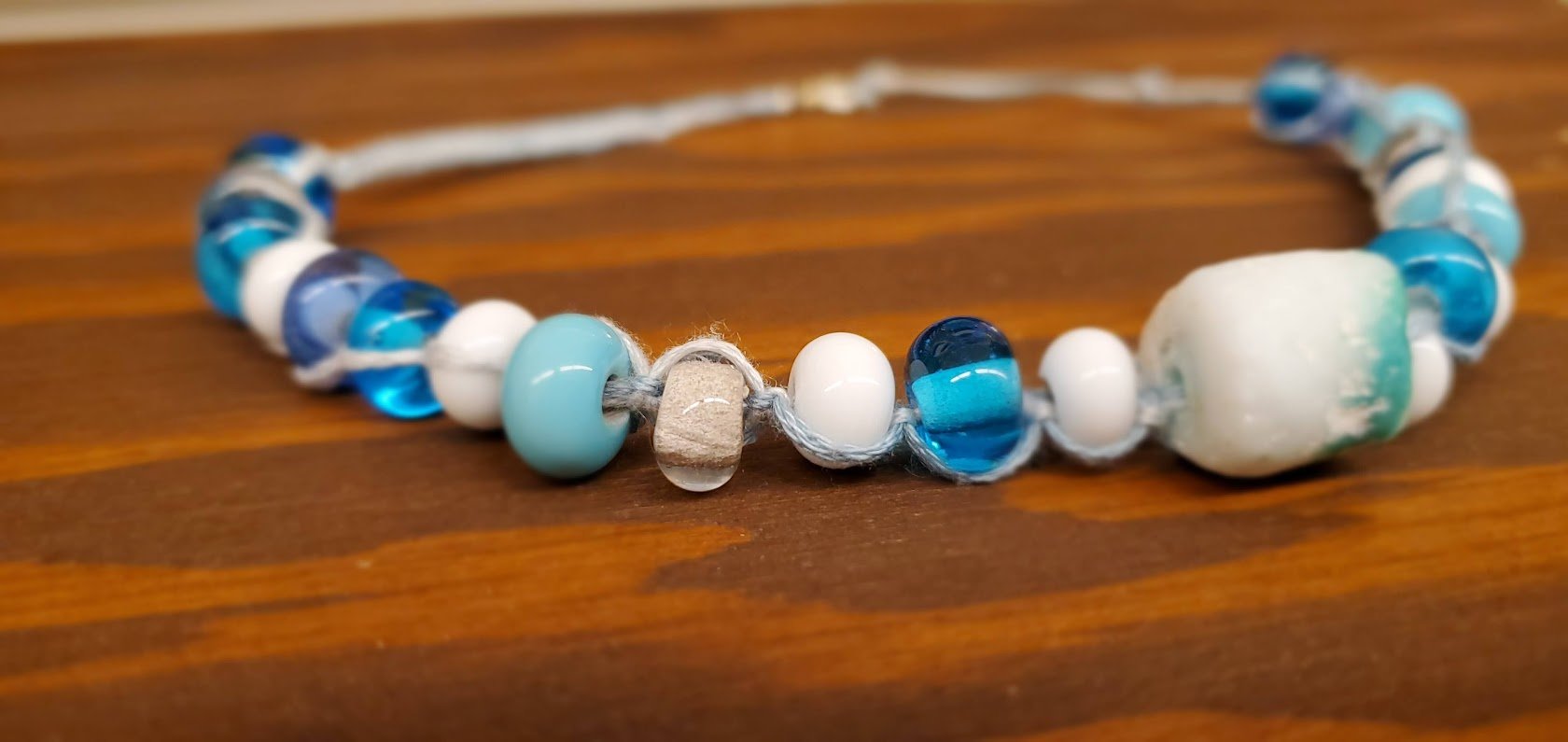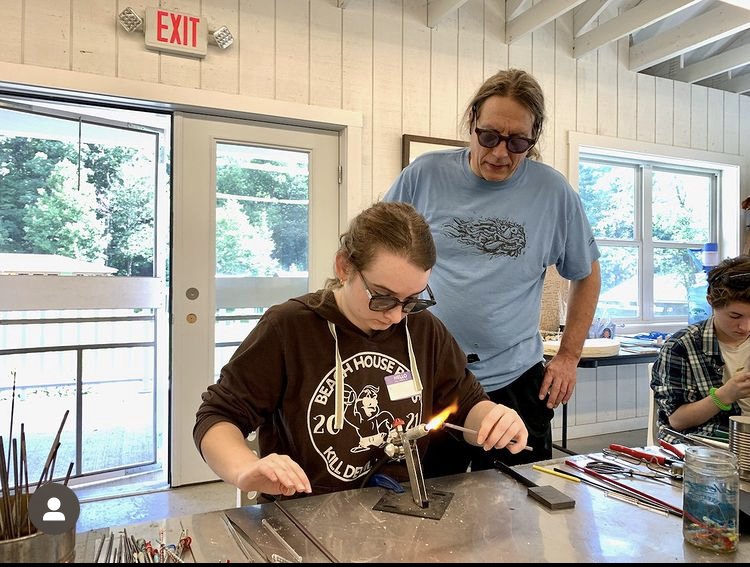The Artistic Ordeal
Today, Katie proudly wears this beautiful necklace of glass beads that she created at summer art camp this year, but for a hot second, when she was literally in the heat of the moment, she was anything but happy. Here is the story of her artistic ordeal and the lessons she learned that sharpened her skill as an artist:
by Katherine Tillia, Commerical Art Class of 2023 (Lincoln High School)
I was excited to learn that my essay had earned me a scholarship to attend the Touchtone Art Camp, and I remember thinking, “I’m going to learn a lot of really cool things!” Little did I know that I’d learn more than I ever thought possible.
One of the courses I took was Glass Torching; I had never worked with this medium before, and I thought it would be good to learn something new.
In class, our main focus was on learning how to make beads and marbles. We made two different types of beads, Krobo beads and regular beads. I learned that Krobo beads are mostly made in Ghana, West Africa; many earn their money by making these beads from discarded items like old glass bottles or tv screens. Ghanaians create Glass Frit, a fine glass powder, and arrange the frit into organic molds. They then heat them in oven kilns.
Making the Krobo beads is more than just creating art; I soon learned that creating these beads is more about teamwork because a single person cannot do it all. One would open the door to the kiln with the Krobo beads while another would hold tongs to carefully extract the molds, all while wearing heat-resistant gloves and a face mask to protect the skin from the heat of the kiln which can burn 1110-1500 degrees Fahrenheit. That person would place the mold on a brick for a third person to make sure that the beads’ holes were open at both ends. That person would insert a small rod into the center while the glass is molten-hot, rolling it around with care and speed. This third person had to be quick because if the glass was left out for too long, it would begin to cool and crack from the drastic change in temperature. Once the hole was created, the final person would take the bead with tweezers and put it into a separate kiln set at a temperature between the previous kiln and room temperature so that the Krobo bead could take time to properly set.
In my opinion, the second bead, the regular bead was much harder to make. In contrast to the Krobo beads, these were done solely by the artist without help from others. When I made this bead, I first dipped a thin metal rod into clay and then held the clay-tipped rods near the top of the flames of the torch just enough so the clay tip would dry and harden but not enough to crack. If the clay cracks, the beads will be permanently welded onto the metal rods.
Next, I placed a glass rod near the fire to warm; doing this mitigates a dangerous situation, for the glass to crack and pop shards risking injury. It is essential to use eye protection when practicing this skill, so I donned all of the protective gear suggested.
Once the glass warmed, I plunged the molten glass fully into the flames to fully melt it, spinning the rod so that the glass heats up the entire way around. Once it starts to melt, I continued to rotate it using gravity to my advantage. This creates a lava glob about the size of a thumbnail.
Once the lava glob is done forming, I took a metal rod and very lightly dabbed the tip of the glob onto the clay of the rod near the top of the flames. It is very important to make sure that I didn’t press too much of the molten glass onto the rod; otherwise, when it cools, it will create a sharp edge on the inside of my bead. As the tip of the lava glob touches the clay I gently pulled back the glass rod while turning the metal rod forward so that the string of lava is being circled around the rod. Depending on how large the artist envisions the bead to be, the metal rod is rotated multiple times to put more than one layer of lava around the rod. After several tries, I finally found success.
I soon found that the farther from the flame the lava glob gets, the harder the glass will start to feel. By keeping close to the edge of the flames, the glass stays warm and gives enough time to shape the bead. When satisfied with the formation of the bead, I pulled back the glass rod so that only a thin piece of glass connected it and melted off as close to the bead as possible.
Rotating the metal rod back and forth allowed me to use gravity as a tool, thus, keeping the bead’s shape consistent. When doing this, I learned that it was good to keep it near the flame to stay warm so that, if it needed it, I could return to the flame without cracking. Once satisfied with the bead, I filled up the rest of the rod with beads which were quickly returned to the fire to stabilize!
It was the second bead, the regular bead, that gave me the most trouble. I struggled to dab the glob of lava onto the rod to start my bead. On one pass, I would put too much on and it would form sharp edges on the sides of the beads. On another, I put too little, and the bead didn’t form right. I felt a bit like Goldilocks – trying to get the glob on the rod “just right.”
Trying to form the bead was a challenge for me as well. I would accidentally make ‘pregnant beads’, as my master teacher, Michael ‘Fig’ Mangiafico, called them; these are beads that have more glass on one side than the other, and they come out lopsided. At times, I felt so frustrated with the process, but I refused to quit. I just kept trying again with more of an understanding of what not to do the next time.
A lot of hand/eye coordination went into this process and once I had gotten better at making the beads, I had this new skill; I’m now noticing an improvement in other projects that require my hands to do what my eyes and mind want them to do.
Overall, my experience at Touchstone was one that helped in so many ways. Not only did I bring home new jewelry, but I also returned with new skills and a new understanding of myself and the world around me to help me in my future.




